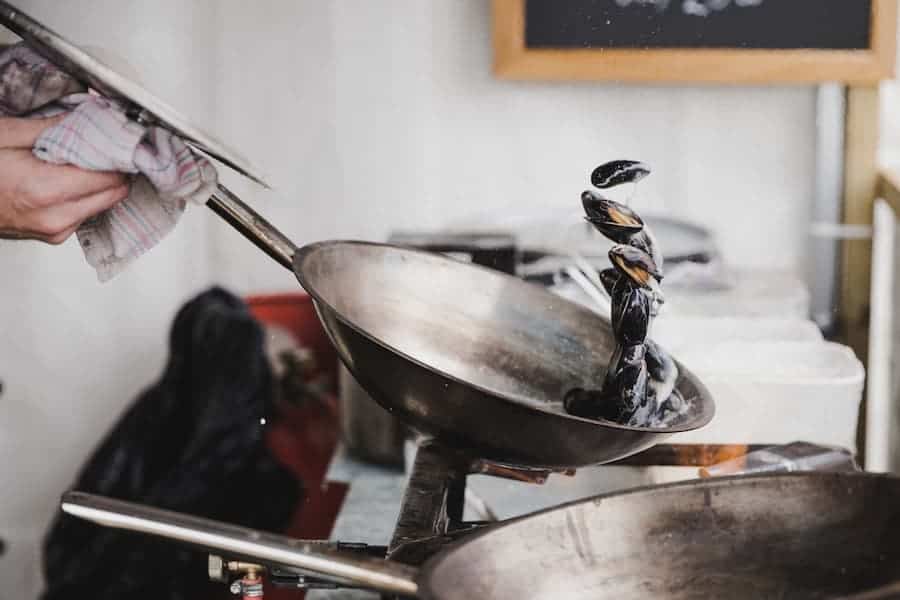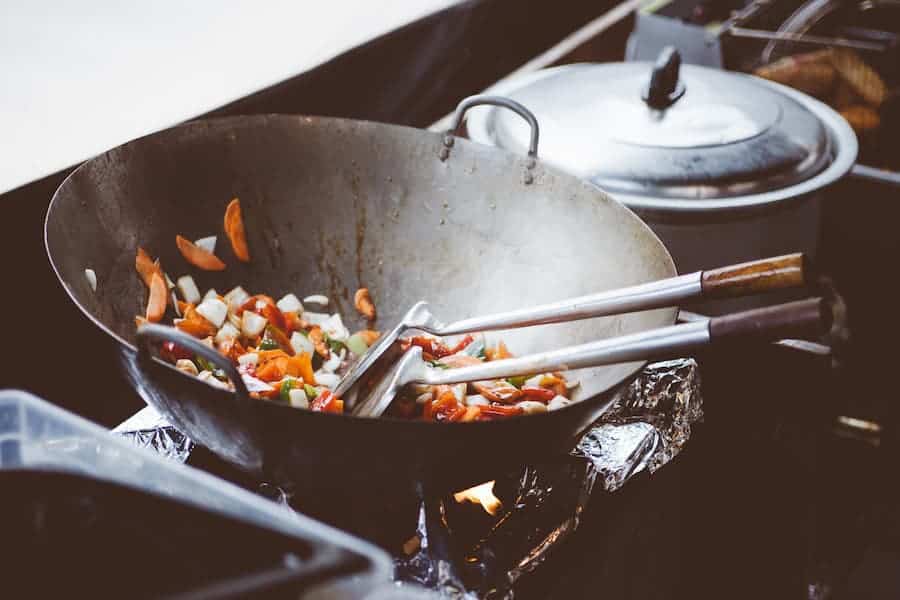As an Amazon Associate we earn from qualifying purchases.
Are you thinking about tossing out your nonstick cookware with Teflon coating and instead use stainless steel pans and pots? Well, stainless steel is a real kitchen workhorse and can be useful in the preparation of just about any type of food. This post will explain how to clean a seasoned stainless steel pan.
This cookware is excellent for marinating, preparing pasta sauce, braising, and even browning meat. The secret is keeping the cookware seasoned properly and cleaned using the correct methods.
Quick Navigation
How to Clean a Seasoned Stainless Steel Pan
If your culinary skills are well-polished, your stainless steel pots can help deliver beautifully cooked meals. I’ll share a few proven tips on how to clean a seasoned stainless steel pan and ways to get rid of stubborn stains.

First things first, why bother to season a stainless steel pan? The answer is simple. Seasoning your pan will naturally turn it into nonstick cookware.
This means you can practically cook anything with it without worrying about your food getting stuck at the bottom or at the sides. Usually, new stainless steel cookware is not seasoned. You should, therefore, get it seasoned before using it.
Once your stainless steel pan is seasoned and you’re ready to clean it, it’s fairly simple.
Step 1: Wipe With Hot Water and a Cloth
To maintain the nonstick properties of your pans and to keep them seasoned, avoid washing them with soap. You only need to wipe them clean using a cloth and hot water.
If you don’t have a cloth, you can also use paper towels.
Step 2: Scrub With Oil and Salt if Needed
In case your pan has stuck-on food, scrub it gently with oil and salt using a wooden or plastic spatula. Only do this if you can’t get everything off with your cloth. Remember to not use soap! If you do, you will need to reseason your pan.
After this, wipe it clean using a cloth or paper towel.
How to Clean Problem Areas
Several surefire ways can help you keep your stainless steel cookware looking as good as new for years. Let me guide you through the recommended methods for cleaning problem areas.
Chalky White Spots
Stainless steel pots can develop chalky spots because of calcium buildup in the water. To remove these unsightly blemishes, use vinegar and water at the ratio of 1:3. Boil the solution in your pan and let it cool.
Next is to clean the cookware as usual and dry it with a soft cloth.
General Buildup
Fill your stainless steel pan with hot soapy water and leave it for several hours. The idea is to let the stuck-on buildup to smoothen.
This makes it unnecessary to use abrasive cleaners or a tough scouring pad to scrub it out. A soft sponge will do the trick after you have soaked your pot in hot soapy water.
To avoid the risk of always getting stuck food bits, avoid adding cold food to a heated stainless steel pan.
For Marks and Discoloration
With time, your stainless steel cookware can adopt a rainbow appearance that is not entirely pleasing to the eye. This is often a result of overheating the pots.

Removing the rainbow appearance is easy. You could wash the pan with vinegar or just use it for cooking high-acid foods such as tomato sauce.
In case your pots have burnt marks, you can easily remove them using boiling water mixed with baking soda.
I also find soda to be quite effective at removing stubborn stains and stuck-on substances. Cola, just like tomatoes, contains acidic properties that do an excellent job of removing tough stains.
General Care for Stainless Steel Pans
Here are a few tips to commit to memory:
- After washing your pots, dry them immediately to prevent nasty water spots.
- In case your pans get light water spots, rub them with a damp cloth and baking powder.
- Always add your salt to boiling water to prevent pitting corrosion. If the water is not boiling, the salt can leave small holes on the sides and bottom of your pan.
- Heat your food to room temperature before adding it to your pan. This will help prevent stuck-on messes.
- Another simple way to prevent sticking is to preheat your stainless steel pans before adding your ingredients. Eliminating cold or hot spots ensures the food cooks more evenly.
- Never use cold water to clean hot stainless steel pans. The difference in temperature causes warping.
- Always use mild cleaners and a soft sponge to protect the stainless steel surfaces from unsightly scratches.
Final Words
Stainless steel cookware is an invaluable asset in the modern kitchen. These pots and pans are designed to effectively distribute heat, making them some of the most useful tools in both commercial and residential culinary settings.
These simple tricks and tips will not only extend the lifespan of your cookware but also help you keep them looking new.
